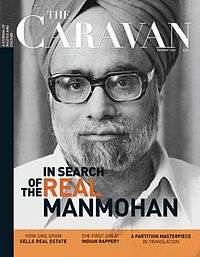The Caravan
The Caravan is an Indian English-language, long-form narrative journalism magazine covering politics and culture. It was relaunched in January 2010 as "India’s only narrative journalism magazine."[2][3]
 October 2011 issue's cover with Manmohan Singh | |
| Editor | Paresh Nath, Editor-in-Chief Anant Nath, Editor Vinod K. Jose, Executive Editor |
|---|---|
| Categories | Politics, culture |
| Frequency | Monthly |
| Circulation | 40,000 (2010)[1] |
| Publisher | Paresh Nath |
| Founder | Vishwa Nath |
| Year founded | 1940 |
| Company | Delhi Press |
| Country | India |
| Based in | Delhi |
| Language | English |
| Website | caravanmagazine |
| ISSN | 0008-6150 |
History

The Caravan was first launched in 1940 by founder Vishwa Nath as Dehli Press's first magazine. The magazine lasted until 1988 when it was closed. The Caravan magazine was revived in 2009 and since its first issue in 2010 it is published from New Delhi, India, by Delhi Press.[3][4][5]
The managing editor called The Caravan an "editorial success, not a business success".[6] The circulation has grown to 40,000 since its launch.[5] As of 2020, the magazine's website gets 1.5 million pageviews per month.[7]
The audience for The Caravan was described as the "pop intelligentsia."[8] The revival was inspired by New Journalism and long-form American magazines such as Harper's Magazine and The New Yorker.[7]
Staff
Paresh Nath is editor-in-chief. His son Anant Nath, the grandson of the original founder, is the managing editor.[7] Vinod K. Jose is the executive editor.[9] While rebuilding The Caravan's brand, the staff was less than 10 and grew three-fold over the next five years.[10] Jonathan Shainin, formerly with The New Yorker, joined the team in 2010 as a senior editor and left to go back to his former employer as a news editor in 2013.[11] As of 2020, The Caravan employed 38 people.
Threats and lawsuits
The magazine has published pieces that are critical of the Rashtriya Swayamsevak Sangh paramilitary organization and some actions of the government of India.[7] Because the magazine does not receive advertisements from the government, it is not possible for the government to use the traditional "carrot and stick" approach to rewarding or punishing journalists by adding or removing paid advertisements according to how pleased the current government is with what they publish.[7]
In addition to receiving threatening messages, the magazine has been sued repeatedly for alleged defamation.[7] These lawsuits are costly and typically take years to fight in court.[7] In 2011, the magazine was the subject of a Rs 50 crore defamation suit by the Indian Institute of Planning and Management after it featured a profile of its head, Arindam Chaudhuri.[12] During the years-long lawsuit, the magazine was ordered to take the article off its website. In 2018, the High Court allowed the magazine to re-publish the article, but the gag order was partly reinstated by a different court two months later.[13][14]
The magazine was issued legal notices in April 2013 regarding its May cover story about Attorney General Goolam Essaji Vahanvati but the top three editors decided to continue with its publication.[15]
In 2015, The Caravan was served a legal notice by the Essar Group because the magazine described the business and the family that runs it unfavorably, including evidence that the business gave iPads to 195 journalists, government employees, and politicians.[16][16] Essar later filed a ₹250 crore civil defamation suit against the magazine; the business did not deny any of the facts presented in the magazine article.[16][17]
References
- Gottipati, Sruthi (10 May 2010). "The Caravan". The New York Review of Magazines. Retrieved 28 June 2018.
- "Delhi Press rolls out 'The Caravan' nationwide". Campaign India. 4 January 2010. Retrieved 9 May 2013.
- "The Caravan completes three years!". adgully.com. 12 February 2013. Retrieved 20 May 2013.
- "The Delhi Press Groups 1st magazine - The Caravan, is back again". Adgully.com. 30 December 2009. Retrieved 3 October 2013.
- "The Caravan – The New York Review of Magazines". Columbia University. 10 May 2010. Retrieved 3 October 2013.
- "Delhi Press bold gamble". Archived from the original on 25 June 2013. Retrieved 22 May 2013.
- Crowell, Maddy (Summer 2020). "The Messengers: One Small Magazine's Fight for the Indian Mind". Virginia Quarterly Review. Retrieved 8 June 2020.
- Shuchi Bansal (24 April 2013). "As magazines dwindle, Delhi Press seeks to add more". Livemint. Retrieved 3 October 2013.
- "Masthead". The Caravan: A Journal of Politics and Culture. Retrieved 20 May 2013.
- "When a Delhi journo joins New Yorker, it's news" (blog). San Serif. 10 October 2013. Retrieved 27 October 2013.
- Joe Pampeo (7 October 2013). "Jonathan Shainin Returning New Yorker". Capital New York. Retrieved 27 October 2013.
- Peri, Maheshwer (27 September 2016). "How IIPM and Arindam Chaudhury used the defamation law to hide the truth". The Scroll.
- "HC lifts gag order on Caravan article on Arindam Chaudhuri of IIPM". The Economic Times. Press Trust of India. 22 February 2018.
- "Delhi High Court Vacates Injunction Against The Caravan's IIPM Cover Story; The Magazine Re-Publishes It". The Caravan. 21 February 2018. Retrieved 8 June 2020.
- "Reliance's pre-emptive legal notices". The Hoot. 20 May 2013. Retrieved 3 October 2013.
- S, Ramanathan (25 August 2015). "Essar goes after The Caravan with lawsuit for damning article, magazine gives it right back". The News Minute.
- "Court grants time to magazine to file reply in defamation suit". The Economic Times. Press Trust of India. 24 August 2015.